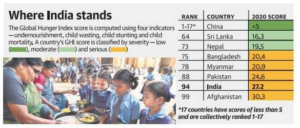In News:
- India has been ranked at 94 among 107 countries in the Global Hunger Index (GHI) 2020.
- Country has the highest prevalence of ‘wasted children’; even Bangladesh and Pakistan score better.
Published By
- Welthungerhilfe and Concern Worldwide.
- GHI scores are calculated each year to assess progress and setbacks in combating hunger.
- This report is released annually.
Highlights
- MORTALITY : 5.3 million children died before their fifth birthdays, in many cases as a result of undernutrition.
- UNDERNOURISHED : Nearly 690 million people are undernourished
- WASTING : 47 million children suffer from wasting, a sign of acute undernutrition
- STUNTING : 144 million children suffer from stunting, a sign of chronic undernutrition
- WORLDWIDE HUNGER : Worldwide hunger is at a moderate level, according to the 2020 Global Hunger Index.
- EMERGENCY : According to 2020 GHI scores, 3 countries have alarming levels of hunger – Chad, Timor-Leste, and Madagascar.
- HIGHEST UNDERNUTRITION : Africa South of the Sahara and South Asia have the highest hunger and undernutrition levels among world regions, with 2020 GHI scores of 27.8 and 26.0.
- ALARM: Hunger is also considered to be alarming in 8 countries – Burundi, Central African Republic, Comoros, Democratic Republic of the Congo, Somalia, South Sudan, Syria, and Yemen .
Indian Scenario:
Overall Performance:
- With a score of 27.2, India has a level of hunger that is “serious”.
- It ranks 94 out of 107 countries in the Index. In 2019, India’s rank was 102 out of 117 countries.
Comparison with Other Countries:
- India features behind Nepal (73), Pakistan (88), Bangladesh (75), Indonesia (70) among others.
- Out of the total 107 countries, only 13 countries fare worse than India including countries like Rwanda (97), Nigeria (98), Afghanistan (99), Liberia (102), Mozambique (103), Chad (107) among others.
Performance on the Indicators:
- Undernourishment: 14% of India’s population is undernourished (2017-19). It was 16.3% during 2011-13.
- Child Wasting: 17.3% (2015-19), it was 15.1% in 2010-14.
- Child Stunting: 34.7%, it has improved significantly, from 54% in 2000 to less than 35% now.
- Child Mortality: 3.7%, it was 5.2% in 2012.

GoI Some Initiatives
- Eat Right India Movement: An outreach activity organised by the Food Safety and Standards Authority of India (FSSAI) for citizens to nudge them towards eating right.
- Pradhan Mantri Matru Vandana Yojana: A centrally sponsored scheme executed by the Ministry of Women and Child Development, is a maternity benefit programme being implemented in all districts of the country with effect from 1st January, 2017.
- POSHAN Abhiyaan: Launched by the Ministry of Women and Child Development in 2018, it targets to reduce stunting, undernutrition, anemia (among young children, women and adolescent girls).
- National Food Security Act, 2013: The National Food Security Act, (NFSA) 2013 legally entitled up to 75% of the rural population and 50% of the urban population to receive subsidized food grains under the Targeted Public Distribution System.
- Food Fortification: Food Fortification or Food Enrichment is the addition of key vitamins and minerals such as iron, iodine, zinc, Vitamin A & D to staple foods such as rice, milk and salt to improve their nutritional content.
- Mission Indradhanush: It targets children under 2 years of age and pregnant women for immunization against 12 Vaccine-Preventable Diseases (VPD).
- Integrated Child Development Services (ICDS) Scheme: Launched on 2nd October, 1975, the Integrated Child Development Services (ICDS) Scheme offers a package of six services (Supplementary Nutrition, Pre-school non-formal education, Nutrition & health education, Immunization, Health check-up and Referral services) to children in the age group of 0-6 years, pregnant women and lactating mothers.
















